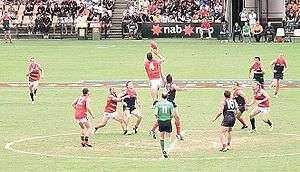Australian rules football in Australia
| Australian rules football in Australia | |
|---|---|
|
Contesting for possession in an indigenous community football game in the Northern Territory | |
| Country | Australia |
| Governing body | Australian Football League |
| National team | Australia |
| First played | 1858, Melbourne, Victoria |
| Registered players | 1,247,610 (total) (2015)[1] |
| Clubs | 13,873[1] |
National competitions | |
Club competitions | |
Audience records | |
| Single match | 121,696 - Collingwood vs Carlton, at the MCG (1970 VFL Grand Final) |
| Season | 7,238,858 - 2011 AFL season[2] |
Australian rules football originated in Melbourne in 1858. It has been played continuously in every state and territory[3] of Australia since 1915, and is particularly popular in Victoria, South Australia, Western Australia, Tasmania and Northern Territory where it is the most watched and most played sport.
The national professional competition is the Australian Football League, which grew out of the former Victorian Football League (not to be confused with the present-day Victorian Football League), changing its name in 1990 after expanding into other states. The AFL now governs the code nationally.
Australian rules football in Australian popular culture
Audience
Attendance
Football is the most highly attended spectator sport in Australia. Government figures show that more than 2.5 million people (16.8% of the population) attended games in 1999.[4] In 2005, a cumulative 6,283,788 people attended Australian Football League (AFL) premiership matches, a record for the competition.[5] A further 307,181 attended NAB Cup pre-season matches and 117,552 attended Regional Challenge pre-season practice matches around the country.[6] As of 2010, the AFL is one of only five professional sports leagues with an average attendance of over 30,000 per game.
As well as the AFL attendances, strong semi-professional state and local competitions also draw crowds. The South Australian SANFL drew an attendance in 2008 of 362,209 with an average of 3,773 per game, while the Western Australian WAFL drew an attendance of 219,205 with an average of 2,332 per game.
Television
According to OzTAM, in recent years, the AFL Grand Final has reached the top five programs across the five biggest cities in 2002, 2003, 2004, 2005 and 2006. Australian rules football has achieved a #1 rating in the sports category in both 2004 and 2005.
Participation
A total of 615,549 registered participants are playing Australian football in 2007, placing it ahead of cricket (471,329 total participants) and soccer (389,000 total participants). Participation rose 5.97% between 2006–07 and 7.84% between 2005-06. 6.7 per cent of all participants are from non-English speaking origin. The Australian Sports Commission statistics show a 42% increase in the total number of participants over the 4-year period between 2001-2005.[7]
Amongst children aged 5 to 14 years, football is the third most popular organised sport for children to participate in (beyond soccer and swimming). An estimated 284,200 children aged 5 to 14 participated in football in the 12 months prior to interview in 2003 (13.6% of all children).[8]
Structure and competitions

The most powerful organisation and competition within the game is the elite professional Australian Football League (AFL). The AFL is recognised by the Australian Sports Commission as being the National Sporting Organisation for Australian rules football. There are also seven state/territory-based organisations in Australia, most of which are affiliated to the AFL. Most of these hold annual semi-professional club competitions while the others oversee more than one league. Local semi-professional or amateur organizations and competitions are affiliated to their state leagues.
National Championships
Senior
The last senior national carnival was held in 1993 and the last match between interstate senior sides was held in 1999. Senior interstate competition is no longer contested by players from the Australian Football League. A one-off exhibition match featuring Victoria and a "Dream Team". However, the state leagues continue to compete in inter-league matches.
Under 18
The AFL Under 18 Championships are the annual national Australian rules football championships for players aged 18 years or younger and includes teams from each Australian state or Territory. The competition is monitored by AFL recruiters and frequently seen as the second biggest pathway for junior players to the fully professional Australian Football League. The competition is currently sponsored by the National Australia Bank. The competition receives an increasing amount of coverage in the media, however still lags behind the TAC Cup in terms of interest in Victoria.
See also
- Australian Football League
- Australian Institute of Sport
- List of Australian rules football clubs in Australia
References
- 1 2 http://www.afl.com.au/news/2015-10-13/womens-participation-in-afl-soars-in-2015
- ↑ http://www.afl.com.au/portals/0/2012/afl_annual_report_2011.pdf
- ↑ excluding Jervis Bay and external territories
- ↑ Sports Attendance, Australian Bureau of Statistics, April 1999.
- ↑ "Aussie Rules sets attendance record". The Sydney Morning Herald. 2005-08-28.
- ↑ 403 Forbidden
- ↑ Participation in Exercise, Recreation and Sport Survey 2005 Annual Report Archived 21 June 2007 at the Wayback Machine.
- ↑ 4901.0 Children's Participation in Cultural and Leisure Activities, Australia (April 2003)
